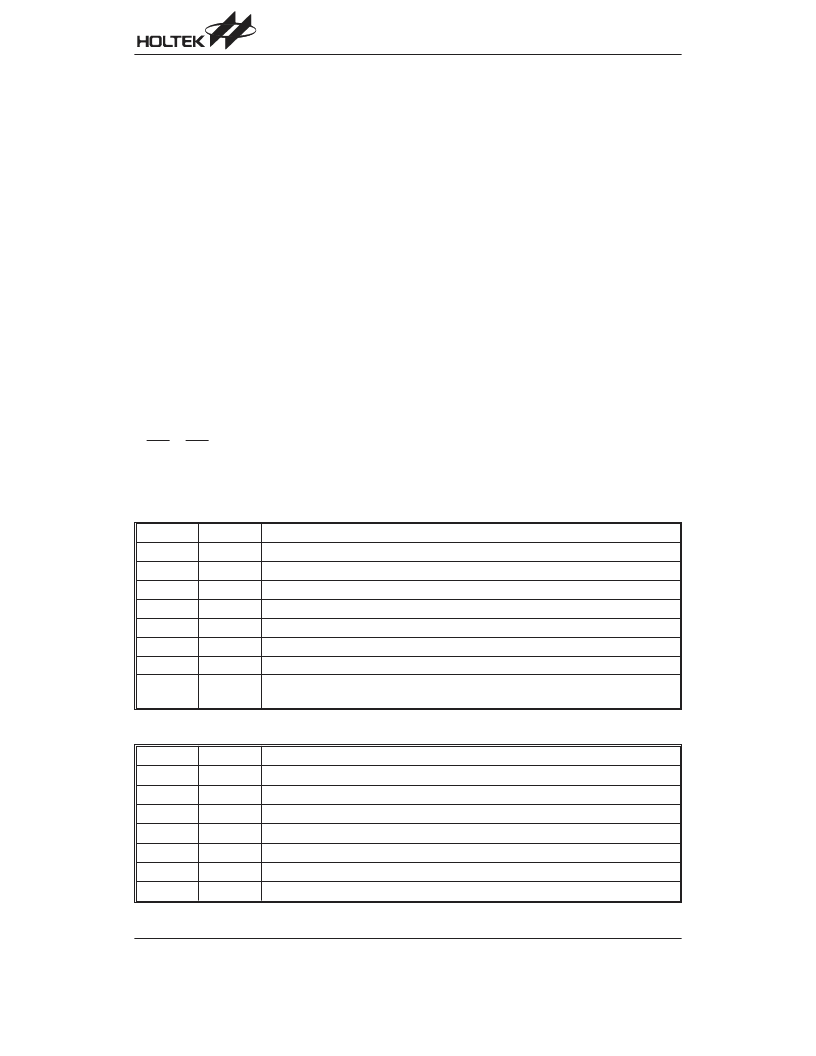- 您現(xiàn)在的位置:買賣IC網(wǎng) > PDF目錄385399 > HT46C62 (Holtek Semiconductor Inc.) A/D with LCD Type 8-Bit MCU PDF資料下載
參數(shù)資料
| 型號: | HT46C62 |
| 廠商: | Holtek Semiconductor Inc. |
| 英文描述: | A/D with LCD Type 8-Bit MCU |
| 中文描述: | 在A / D液晶型8位微控制器 |
| 文件頁數(shù): | 11/46頁 |
| 文件大?。?/td> | 401K |
| 代理商: | HT46C62 |
第1頁第2頁第3頁第4頁第5頁第6頁第7頁第8頁第9頁第10頁當(dāng)前第11頁第12頁第13頁第14頁第15頁第16頁第17頁第18頁第19頁第20頁第21頁第22頁第23頁第24頁第25頁第26頁第27頁第28頁第29頁第30頁第31頁第32頁第33頁第34頁第35頁第36頁第37頁第38頁第39頁第40頁第41頁第42頁第43頁第44頁第45頁第46頁

HT46R62/HT46C62
Rev. 1.60
11
July 14, 2005
Once an interrupt subroutine is serviced, other inter-
rupts are all blocked (by clearing the EMI bit). This
scheme may prevent any further interrupt nesting. Other
interrupt requests may take place during this interval,
but only the interrupt request flag will be recorded. If a
certain interrupt requires servicing within the service
routine, the EMI bit and the corresponding bit of the
INTC0 or of INTC1 may be set in order to allow interrupt
nesting. Once the stack is full, the interrupt request will
not be acknowledged, even if the related interrupt is en-
abled, until the SP is decremented. If immediate service
is desired, the stack should be prevented from becom-
ing full.
All these interrupts can support a wake-up function. As
an interrupt is serviced, a control transfer occurs by
pushing the contents of the program counter onto the
stack followed by a branch to a subroutine at the speci-
fied location in the ROM. Only the contents of the pro-
gram counter is pushed onto the stack. If the contents of
the register or of the status register (STATUS) is altered
by the interrupt service program which corrupts the de-
sired control sequence, the contents should be saved in
advance.
External interrupts are triggered by a an edge transition
of INT0 or INT1 (option: high to low, low to high, low to
highorhightolow),andtherelatedinterruptrequestflag
(EIF0; bit 4 of INTC0, EIF1; bit 5 of INTC0) is set as well.
After the interrupt is enabled, the stack is not full, and
the external interrupt is active, a subroutine call to loca-
tion 04H or 08H occurs. The interrupt request flag (EIF0
or EIF1) and EMI bits are all cleared to disable other
maskable interrupts.
The internal Timer/Event Counter interrupt is initialized
by setting the Timer/Event Counter interrupt request flag
(TF; bit 6 of INTC0), which is normally caused by a timer
overflow. After the interrupt is enabled, and the stack is
not full, and the TF bit is set, a subroutine call to location
0CH occurs. The related interrupt request flag (TF) is re-
set,andtheEMIbitisclearedtodisablefurtherinterrupts.
The time base interrupt is initialized by setting the time
base interrupt request flag (TBF; bit 5 of INTC1), that is
caused by a regular time base signal. After the interrupt
is enabled, and the stack is not full, and the TBF bit is
set, a subroutine call to location 14H occurs. The related
interrupt request flag (TBF) is reset and the EMI bit is
cleared to disable further maskable interrupts.
The real time clock interrupt is initialized by setting the
real time clock interrupt request flag (RTF; bit 6 of
INTC1), that is caused by a regular real time clock sig-
nal. After the interrupt is enabled, and the stack is not
full, and the RTF bit is set, a subroutine call to location
18H occurs. The related interrupt request flag (RTF) is
reset and the EMI bit is cleared to disable further inter-
rupts.
During the execution of an interrupt subroutine, other in-
terrupt acknowledgments are all held until the RETI
instruction is executed or the EMI bit and the related in-
Bit No.
Label
Function
0
EMI
Control the master (global) interrupt (1=enabled; 0=disabled)
1
EEI0
Control the external interrupt 0 (1=enabled; 0=disabled)
2
EEI1
Control the external interrupt 1 (1=enabled; 0=disabled)
3
ETI
Control the Timer/Event Counter interrupt (1=enabled; 0=disabled)
4
EIF0
External interrupt 0 request flag (1=active; 0=inactive)
5
EIF1
External interrupt 1 request flag (1=active; 0=inactive)
6
TF
Internal Timer/Event Counter request flag (1=enable; 0=disable)
7
For test mode used only.
Must be written as 0 ; otherwise may result in unpredictable operation.
INTC0 (0BH) Register
Bit No.
Label
Function
0
Unused bit, read as 0
1
ETBI
Control the time base interrupt (1=enabled; 0:disabled)
2
ERTI
Control the real time clock interrupt (1=enabled; 0:disabled)
3, 4
Unused bit, read as 0
5
TBF
Time base request flag (1=active; 0=inactive)
6
RTF
Real time clock request flag (1=active; 0=inactive)
7
Unused bit, read as 0
INTC1 (1EH) Register
相關(guān)PDF資料 |
PDF描述 |
|---|---|
| HT46R62 | A/D with LCD Type 8-Bit MCU |
| HT46C63 | A/D with LCD Type 8-Bit MCU |
| HT46C63-100QEP-A | A/D with LCD Type 8-Bit MCU |
| HT46C63-56SSOP-A | A/D with LCD Type 8-Bit MCU |
| HT46R63 | A/D with LCD Type 8-Bit MCU |
相關(guān)代理商/技術(shù)參數(shù) |
參數(shù)描述 |
|---|---|
| HT46C63 | 制造商:HOLTEK 制造商全稱:Holtek Semiconductor Inc 功能描述:A/D with LCD Type 8-Bit MCU |
| HT46C63(100QFP) | 制造商:未知廠家 制造商全稱:未知廠家 功能描述:Microcontroller |
| HT46C63-100QEP-A | 制造商:HOLTEK 制造商全稱:Holtek Semiconductor Inc 功能描述:A/D with LCD Type 8-Bit MCU |
| HT46C63-56SSOP-A | 制造商:HOLTEK 制造商全稱:Holtek Semiconductor Inc 功能描述:A/D with LCD Type 8-Bit MCU |
| HT46C64 | 制造商:HOLTEK 制造商全稱:Holtek Semiconductor Inc 功能描述:A/D with LCD Type 8-Bit MCU |
發(fā)布緊急采購,3分鐘左右您將得到回復(fù)。